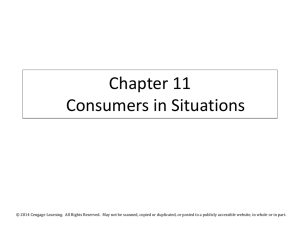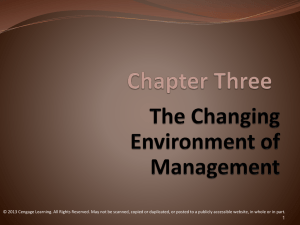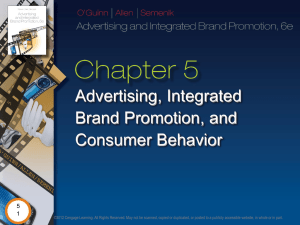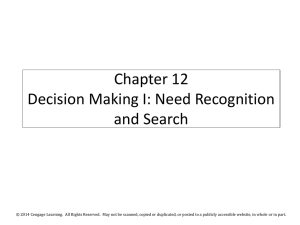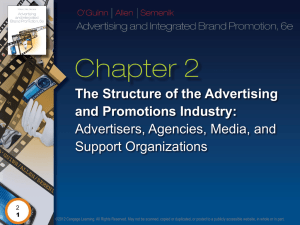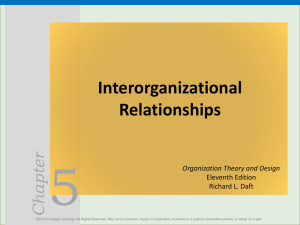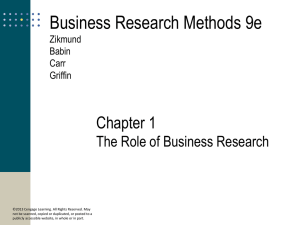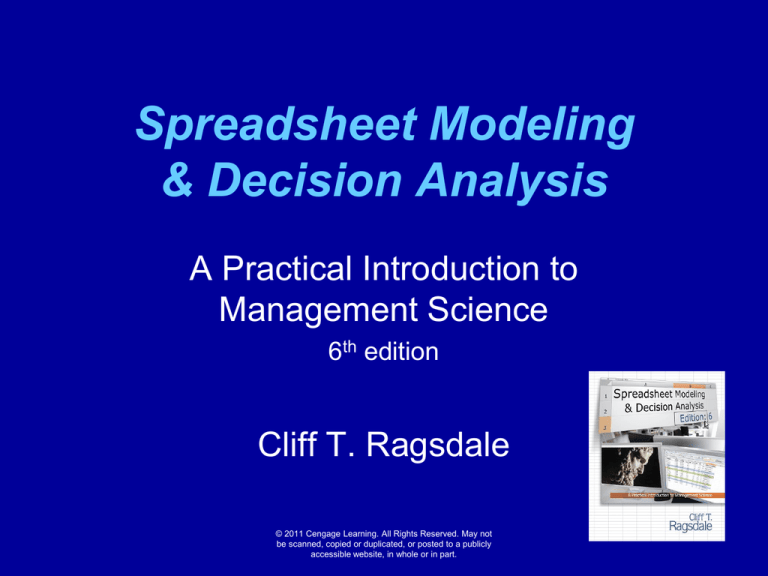
Spreadsheet Modeling
& Decision Analysis
A Practical Introduction to
Management Science
6th edition
Cliff T. Ragsdale
© 2011 Cengage Learning. All Rights Reserved. May not
be scanned, copied or duplicated, or posted to a publicly
accessible website, in whole or in part.
Chapter 2
Introduction to Optimization
and Linear Programming
© 2011 Cengage Learning. All Rights Reserved. May not
be scanned, copied or duplicated, or posted to a publicly
accessible website, in whole or in part.
Introduction
We all face decision about how to use
limited resources such as:
– Oil in the earth
– Land for dumps
– Time
– Money
– Workers
© 2011 Cengage Learning. All Rights Reserved. May not
be scanned, copied or duplicated, or posted to a publicly
accessible website, in whole or in part.
Mathematical Programming...
MP is a field of management science that
finds the optimal, or most efficient, way of
using limited resources to achieve the
objectives of an individual of a business.
a.k.a. Optimization
© 2011 Cengage Learning. All Rights Reserved. May not
be scanned, copied or duplicated, or posted to a publicly
accessible website, in whole or in part.
Applications of Optimization
Determining Product Mix
Manufacturing
Routing and Logistics
Financial Planning
© 2011 Cengage Learning. All Rights Reserved. May not
be scanned, copied or duplicated, or posted to a publicly
accessible website, in whole or in part.
Characteristics of
Optimization Problems
Decisions
Constraints
Objectives
© 2011 Cengage Learning. All Rights Reserved. May not
be scanned, copied or duplicated, or posted to a publicly
accessible website, in whole or in part.
General Form of an Optimization Problem
MAX (or MIN): f0(X1, X2, …, Xn)
Subject to:
f1(X1, X2, …, Xn)<=b1
:
fk(X1, X2, …, Xn)>=bk
:
fm(X1, X2, …, Xn)=bm
Note: If all the functions in an optimization are linear,
the problem is a Linear Programming (LP) problem
© 2011 Cengage Learning. All Rights Reserved. May not
be scanned, copied or duplicated, or posted to a publicly
accessible website, in whole or in part.
Linear Programming (LP) Problems
MAX (or MIN): c1X1 + c2X2 + … + cnXn
Subject to:
a11X1 + a12X2 + … + a1nXn <= b1
:
ak1X1 + ak2X2 + … + aknXn >=bk
:
am1X1 + am2X2 + … + amnXn = bm
© 2011 Cengage Learning. All Rights Reserved. May not
be scanned, copied or duplicated, or posted to a publicly
accessible website, in whole or in part.
An Example LP Problem
Blue Ridge Hot Tubs produces two types of hot
tubs: Aqua-Spas & Hydro-Luxes.
Pumps
Labor
Tubing
Unit Profit
Aqua-Spa
1
9 hours
12 feet
$350
Hydro-Lux
1
6 hours
16 feet
$300
There are 200 pumps, 1566 hours of labor,
and 2880 feet of tubing available.
© 2011 Cengage Learning. All Rights Reserved. May not
be scanned, copied or duplicated, or posted to a publicly
accessible website, in whole or in part.
5 Steps In Formulating LP Models:
1. Understand the problem.
2. Identify the decision variables.
X1=number of Aqua-Spas to produce
X2=number of Hydro-Luxes to produce
3. State the objective function as a linear
combination of the decision variables.
MAX: 350X1 + 300X2
© 2011 Cengage Learning. All Rights Reserved. May not
be scanned, copied or duplicated, or posted to a publicly
accessible website, in whole or in part.
5 Steps In Formulating LP Models
(continued)
4. State the constraints as linear combinations
of the decision variables.
1X1 + 1X2 <= 200
} pumps
9X1 + 6X2 <= 1566
} labor
12X1 + 16X2 <= 2880 } tubing
5. Identify any upper or lower bounds on the
decision variables.
X1 >= 0
X2 >= 0
© 2011 Cengage Learning. All Rights Reserved. May not
be scanned, copied or duplicated, or posted to a publicly
accessible website, in whole or in part.
LP Model for
Blue Ridge Hot Tubs
MAX: 350X1 + 300X2
S.T.: 1X1 + 1X2 <= 200
9X1 + 6X2 <= 1566
12X1 + 16X2 <= 2880
X1 >= 0
X2 >= 0
© 2011 Cengage Learning. All Rights Reserved. May not
be scanned, copied or duplicated, or posted to a publicly
accessible website, in whole or in part.
Solving LP Problems:
An Intuitive Approach
Idea: Each Aqua-Spa (X1) generates the highest unit
profit ($350), so let’s make as many of them as possible!
How many would that be?
– Let X2 = 0
1st constraint:
1X1 <= 200
2nd constraint:
9X1 <=1566 or X1 <=174
3rd constraint:
12X1 <= 2880 or X1 <= 240
If X2=0, the maximum value of X1 is 174 and the total
profit is $350*174 + $300*0 = $60,900
This solution is feasible, but is it optimal?
No!
© 2011 Cengage Learning. All Rights Reserved. May not
be scanned, copied or duplicated, or posted to a publicly
accessible website, in whole or in part.
Solving LP Problems:
A Graphical Approach
The constraints of an LP problem
defines its feasible region.
The best point in the feasible region is
the optimal solution to the problem.
For LP problems with 2 variables, it is
easy to plot the feasible region and find
the optimal solution.
© 2011 Cengage Learning. All Rights Reserved. May not
be scanned, copied or duplicated, or posted to a publicly
accessible website, in whole or in part.
Plotting the First Constraint
X2
250
(0, 200)
200
boundary line of pump constraint
X1 + X2 = 200
150
100
50
(200, 0)
0
0
50
100
150
200
© 2011 Cengage Learning. All Rights Reserved. May not
be scanned, copied or duplicated, or posted to a publicly
accessible website, in whole or in part.
250
X1
Plotting the Second Constraint
X2
(0, 261)
250
boundary line of labor constraint
9X1 + 6X2 = 1566
200
150
100
50
(174, 0)
0
0
50
100
150
200
© 2011 Cengage Learning. All Rights Reserved. May not
be scanned, copied or duplicated, or posted to a publicly
accessible website, in whole or in part.
250
X1
Plotting the Third Constraint
X2
250
(0, 180)
200
150
boundary line of tubing constraint
12X1 + 16X2 = 2880
100
Feasible Region
50
(240, 0)
0
0
50
100
150
200
© 2011 Cengage Learning. All Rights Reserved. May not
be scanned, copied or duplicated, or posted to a publicly
accessible website, in whole or in part.
250
X1
Plotting A Level Curve of the
Objective Function
X2
250
200
(0, 116.67)
objective function
150
350X1 + 300X2 = 35000
100
(100, 0)
50
0
0
50
100
150
200
© 2011 Cengage Learning. All Rights Reserved. May not
be scanned, copied or duplicated, or posted to a publicly
accessible website, in whole or in part.
250
X1
A Second Level Curve of the
Objective Function
X2
250
(0, 175)
200
objective function
350X1 + 300X2 = 35000
objective function
350X1 + 300X2 = 52500
150
100
(150, 0)
50
0
0
50
100
150
200
© 2011 Cengage Learning. All Rights Reserved. May not
be scanned, copied or duplicated, or posted to a publicly
accessible website, in whole or in part.
250
X1
Using A Level Curve to Locate
the Optimal Solution
X2
250
objective function
350X1 + 300X2 = 35000
200
150
optimal solution
100
objective function
350X1 + 300X2 = 52500
50
0
0
50
100
150
200
© 2011 Cengage Learning. All Rights Reserved. May not
be scanned, copied or duplicated, or posted to a publicly
accessible website, in whole or in part.
250
X1
Calculating the Optimal Solution
The optimal solution occurs where the “pumps” and
“labor” constraints intersect.
This occurs where:
X1 + X2 = 200
(1)
and 9X1 + 6X2 = 1566
(2)
From (1) we have, X2 = 200 -X1
(3)
Substituting (3) for X2 in (2) we have,
9X1 + 6 (200 -X1) = 1566
which reduces to X1 = 122
So the optimal solution is,
X1=122, X2=200-X1=78
Total Profit = $350*122 + $300*78 = $66,100
© 2011 Cengage Learning. All Rights Reserved. May not
be scanned, copied or duplicated, or posted to a publicly
accessible website, in whole or in part.
Enumerating The Corner Points
X2
250
obj. value = $54,000
(0, 180)
200
Note: This technique will not work if
the solution is unbounded.
obj. value = $64,000
150
(80, 120)
obj. value = $66,100
(122, 78)
100
50
obj. value = $60,900
(174, 0)
obj. value = $0
(0, 0)
0
0
50
100
150
200
© 2011 Cengage Learning. All Rights Reserved. May not
be scanned, copied or duplicated, or posted to a publicly
accessible website, in whole or in part.
250
X1
Summary of Graphical Solution
to LP Problems
1. Plot the boundary line of each constraint
2. Identify the feasible region
3. Locate the optimal solution by either:
a. Plotting level curves
b. Enumerating the extreme points
© 2011 Cengage Learning. All Rights Reserved. May not
be scanned, copied or duplicated, or posted to a publicly
accessible website, in whole or in part.
Understanding How Things Change
See file Fig2-8.xlsm
© 2011 Cengage Learning. All Rights Reserved. May not
be scanned, copied or duplicated, or posted to a publicly
accessible website, in whole or in part.
Special Conditions in LP Models
A number of anomalies can occur in LP
problems:
– Alternate Optimal Solutions
– Redundant Constraints
– Unbounded Solutions
– Infeasibility
© 2011 Cengage Learning. All Rights Reserved. May not
be scanned, copied or duplicated, or posted to a publicly
accessible website, in whole or in part.
Example of Alternate Optimal Solutions
X2
250
objective function level curve
450X1 + 300X2 = 78300
200
150
100
alternate optimal solutions
50
0
0
50
100
150
200
© 2011 Cengage Learning. All Rights Reserved. May not
be scanned, copied or duplicated, or posted to a publicly
accessible website, in whole or in part.
250
X1
Example of a Redundant Constraint
X2
250
boundary line of tubing constraint
200
boundary line of pump constraint
150
boundary line of labor constraint
100
Feasible Region
50
0
0
50
100
150
200
© 2011 Cengage Learning. All Rights Reserved. May not
be scanned, copied or duplicated, or posted to a publicly
accessible website, in whole or in part.
250
X1
Example of an Unbounded Solution
X2
1000
objective function
X1 + X2 = 600
800
-X1 + 2X2 = 400
objective function
X1 + X2 = 800
600
400
200
X1 + X2 = 400
0
0
200
400
600
800
© 2011 Cengage Learning. All Rights Reserved. May not
be scanned, copied or duplicated, or posted to a publicly
accessible website, in whole or in part.
1000
X1
Example of Infeasibility
X2
250
200
X1 + X2 = 200
feasible region for
second constraint
150
100
feasible region
for first
constraint
50
X1 + X2 = 150
0
0
50
100
150
200
© 2011 Cengage Learning. All Rights Reserved. May not
be scanned, copied or duplicated, or posted to a publicly
accessible website, in whole or in part.
250
X1
End of Chapter 2
© 2011 Cengage Learning. All Rights Reserved. May not
be scanned, copied or duplicated, or posted to a publicly
accessible website, in whole or in part.
The Risk Solver Platform software
featured in this book is provided
by Frontline Systems.
http://www.solver.com
© 2011 Cengage Learning. All Rights Reserved. May not
be scanned, copied or duplicated, or posted to a publicly
accessible website, in whole or in part.


